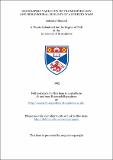Files in this item
Geographic variation in the morphology and behavioural ecology of a sphecid wasp
Item metadata
| dc.contributor.advisor | Willmer, Pat | |
| dc.contributor.author | Ghazoul, Jaboury | |
| dc.coverage.spatial | 296 p. | en_US |
| dc.date.accessioned | 2018-07-04T14:41:51Z | |
| dc.date.available | 2018-07-04T14:41:51Z | |
| dc.date.issued | 1993 | |
| dc.identifier.uri | https://hdl.handle.net/10023/14929 | |
| dc.description.abstract | A comparative study between populations of Mellinus arvensis (Hymenoptera: Sphecidae) was carried out in Britain. Large variations in size were found between populations and these were correlated with environmental, thermal, and biological factors. A latitudinal dine accounted for some of the variation, with larger wasps found at southerly locations. This was partially explained by climatic patterns and wasp warm-up rates. A hypothesis involving the interaction of environmental, behavioural and morphological factors was suggested to account for the remaining unexplained size variation between populations. It was found that at sites where the ground is compact and difficult to dig through, nests are more valuable in terms of time required to dig them. A strategy of searching for rather than digging a nest becomes viable. Wasps do not seem to be able to distinguish between occupied and abandoned nests, and aggressive interactions at nests occur between wasps searching for a nest and the nest residents. Aggression is more frequent at sites where pressure from searchers is greatest, that is, at sites where nest construction is most difficult and costly. Consequently, large wasps, which have greater success in aggressive encounters, are selected for at these sites. At sites where the ground is loose and easy to dig through, a more successful reproductive tactic appears to be maximisation of offspring number, resulting in many, small offspring. Behavioural observations suggested that M. arvensis is capable of, at least, limited endothermy, although this could not be confirmed in laboratory experiments. Similar observations and results were obtained from several other sphecid species. However, endothermy was found in two sphecid species of the genus Bembix in Portugal, suggesting that endothermy may be more widespread than previously thought. | en_US |
| dc.language.iso | en | en_US |
| dc.publisher | University of St Andrews | |
| dc.subject.lcc | QL568.S7G2 | en |
| dc.subject.lcsh | Sphecidae | en |
| dc.title | Geographic variation in the morphology and behavioural ecology of a sphecid wasp | en_US |
| dc.type | Thesis | en_US |
| dc.type.qualificationlevel | Doctoral | en_US |
| dc.type.qualificationname | PhD Doctor of Philosophy | en_US |
| dc.publisher.institution | The University of St Andrews | en_US |
This item appears in the following Collection(s)
Items in the St Andrews Research Repository are protected by copyright, with all rights reserved, unless otherwise indicated.

